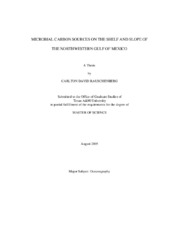Microbial carbon sources on the shelf and slope of the northwestern Gulf of Mexico
Abstract
Over the past five years, gas chromatography/combustion/isotope ratio mass
spectrometry (GC/C/IRMS) analyses of phospholipid fatty acids (PLFAs) has been
increasingly used to link organic matter (OM) sources with sedimentary bacteria. This
technique has been applied across diverse estuarine and coastal sediments, including
lower Laguna Madre, TX, an oligotrophic, coastal lagoon dominated by a single OM
source, seagrasses; shelf stations, a eutrophic coastal region receiving multiple sources
of OM, hypoxic regions that occur seasonally and deep slope and abyssal plain
sediments of the Gulf of Mexico (GOM). Previous reports using the Laguna Madre data
as examples, have been used to make comparisons of PLFA 16:0 and PLFA 15:0 isotope
ratios and PLFA 16:0 and total organic carbon isotope ratios. Deviations from the 1:1
line in the former indicate living or recently senescent sources of organic matter are not
predominantly bacterial. Deviations from the 1:1 line in the latter indicate living or
recently senescent sources of organic matter differ isotopically from detrital or older OM
in sediments. Prior to the work of Goni et al. (1998), carbon isotope ratios of OM in
GOM sediments were interpreted as marine in origin. Based on a series of geochemical
measurements, Goni et al. suggested that GOM sediments are largely composed of
terrestrial organic carbon (OCterr). Furthermore, They went on to show that shelf and
slope sediments were primarily C3 and C4 respectively. I report on the preferential
utilization of autochthonous OM by sedimentary bacteria at the sediment surface and the
shift to recalcitrant, terrestrially derived OM with depth.
Citation
Rauschenberg, Carlton David (2005). Microbial carbon sources on the shelf and slope of the northwestern Gulf of Mexico. Master's thesis, Texas A&M University. Texas A&M University. Available electronically from https : / /hdl .handle .net /1969 .1 /4173.


